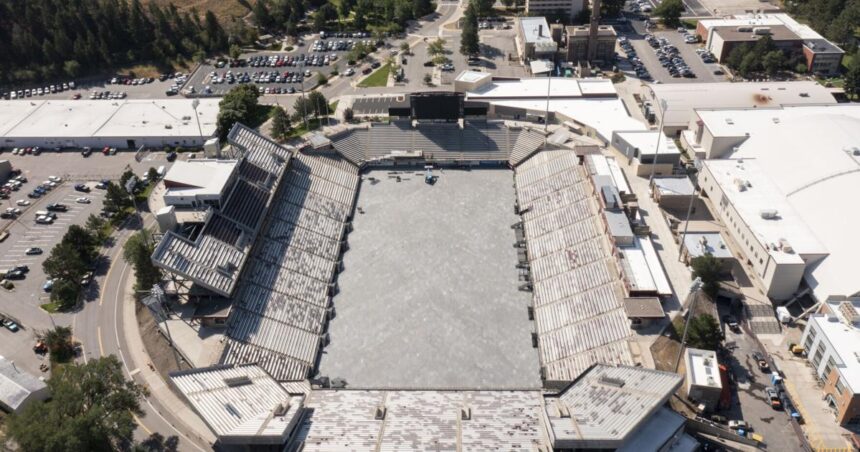In a span of seven days, Washington-Grizzly Stadium will host three sold-out shows with an estimated combined attendance of 72,000.
Prior to this year’s concert series with Pearl Jam, Tyler Childers, and Pink, the University of Montana had only booked musical acts there six times. In the years ahead, you’re likely to see more.
“Our goal is to continue to do shows like this, and we want to expand the number,” UM President Seth Bodnar said.
While it’s too early to give an exact count, UM plans to continue working with promoters to help make the campus and city a destination.
“We want to put Missoula on the map as a place that big, globally recognized acts want to make part of their tour,” he said.
As Missoula’s a hub in the region for arts and culture, UM believes it’s a benefit for the campus, the city, and the state as a whole.
People are also reading…
“One of the beautiful things about this university is that it enables and creates opportunities for people in a place like Missoula to have the best of both worlds — to get to live in a community like Missoula, to be close to the great opportunities of outdoor living in Montana, but also have acts like this that give you the benefits of being in a large city,” Bodnar said.
Paula Short, associate vice president of campus operations, preparedness, and response, said that historically the city was more of a convenient stop on a tour route. But it’s becoming “a little more of a destination.”
“Washington-Grizzly Stadium has brought some really amazing acts, and I think as we continue to offer more shows in the stadium, we’re just going to get the word out even more,” Short said.
Crews work to prepare Washington-Grizzly Stadium for a string of concerts over the next seven days. Pearl Jam, Tyler Childers, and Pink will all perform over the next week with an estimated combined attendance of 72,000.
That confidence comes in part from its scenic location at the base of the mountain in a place that’s already seeing record numbers of large, ticketed outdoor concerts, which this year adds up to 45 at major venues in Missoula alone.
For this series, UM has teamed up with Live Nation, which it’s worked with in the past on concerts at the university’s venues like the Adams Center and Dennison Theatre. (Earlier this year, the Department of Justice accused Live Nation of holding a monopoly in the live music industry.)
The increased use of the stadium is possible because of the construction of an indoor practice facility for UM’s sports teams.
“Being able to have that indoor facility gives us the opportunity to have enough infrastructure so that concerts aren’t directly competing or impacting what we need the stadium for with regard to athletics,” Short said.
All three bands can use the same stage, which requires at least three days to install.
Each act has its own needs. Pink, for instance, has played massive stadiums around the U.S. with choreographed aerial acrobatics in which she’s lifted high off the stage and “flies” over the crowds.
The shows are timed to greet students back for the year. On UM’s calendar, the first-year freshman students will be on campus for orientation during Pearl Jam (Thursday, Aug. 22) and Tyler Childers and Nathaniel Rateliff (Saturday, Aug. 24). The first day of class is Monday, Aug. 26, and Pink’s concert lands on Wednesday, Aug. 28.
The sound of money
Regarding money, Dave Kuntz, UM’s director of strategic communications, said compensation comes from “a rental fee and ancillary revenues such as parking, food and beverage sales, merchandise share and ticket fees. It is too early to put a ballpark figure on the revenue, but we expect to measure it in the metric of ‘hundreds of thousands of dollars.’”
The concerts also bring in outside spending to the community as a whole. There haven’t been any economic impact studies specifically for a UM stadium concert. However, in 2016, the university’s Bureau of Business and Economic Research analyzed the economic impact of Griz sports. It estimated that every home football game results in $2.5 million in spending from attendees coming from outside the area.
That’s the most recent study, so the figure doesn’t account for years of inflation. Bodnar said the economic impact for a stadium concert would be higher, since home games are attended by people from out of town who drive home after the game, while concert attendees are far more likely to stay overnight.
Jeff Trisler, Live Nation Northwest regional vice president, said he didn’t have any data on where tickets sales are coming from: “only that they are coming, happily.”
Pink is the first contemporary pop musician (and female headliner) to play the stadium, which typically hosts rock and Americana acts. Asked whether Live Nation is considering bringing in more pop acts, Trisler said they’ll “assess on a case-by-case basis depending on artist availability and venue ability,” adding that “interest from the artist community in performing in Montana is high.”
When selecting the artists, Trisler said they rely on professional judgment to determine “whether or not audience demand is there. Fortunately, we were right on all three as the demand and interest in all three very diverse shows has been very high.”





